Online target-speech extraction method based on auxiliary function for robust automatic speech recognition
Park , et al. April 27, 2
U.S. patent number 10,991,362 [Application Number 16/849,321] was granted by the patent office on 2021-04-27 for online target-speech extraction method based on auxiliary function for robust automatic speech recognition. This patent grant is currently assigned to INDUSTRY-UNIVERSITY COOPERATION FOUNDATION SOGANG UNIVERSITY. The grantee listed for this patent is INDUSTRY-UNIVERSITY COOPERATION FOUNDATION SOGANG UNIVERSITY. Invention is credited to Byung Joon Cho, Seung-Yun Kim, Seoyoung Lee, Hyung Min Park, Uihyeop Shin.



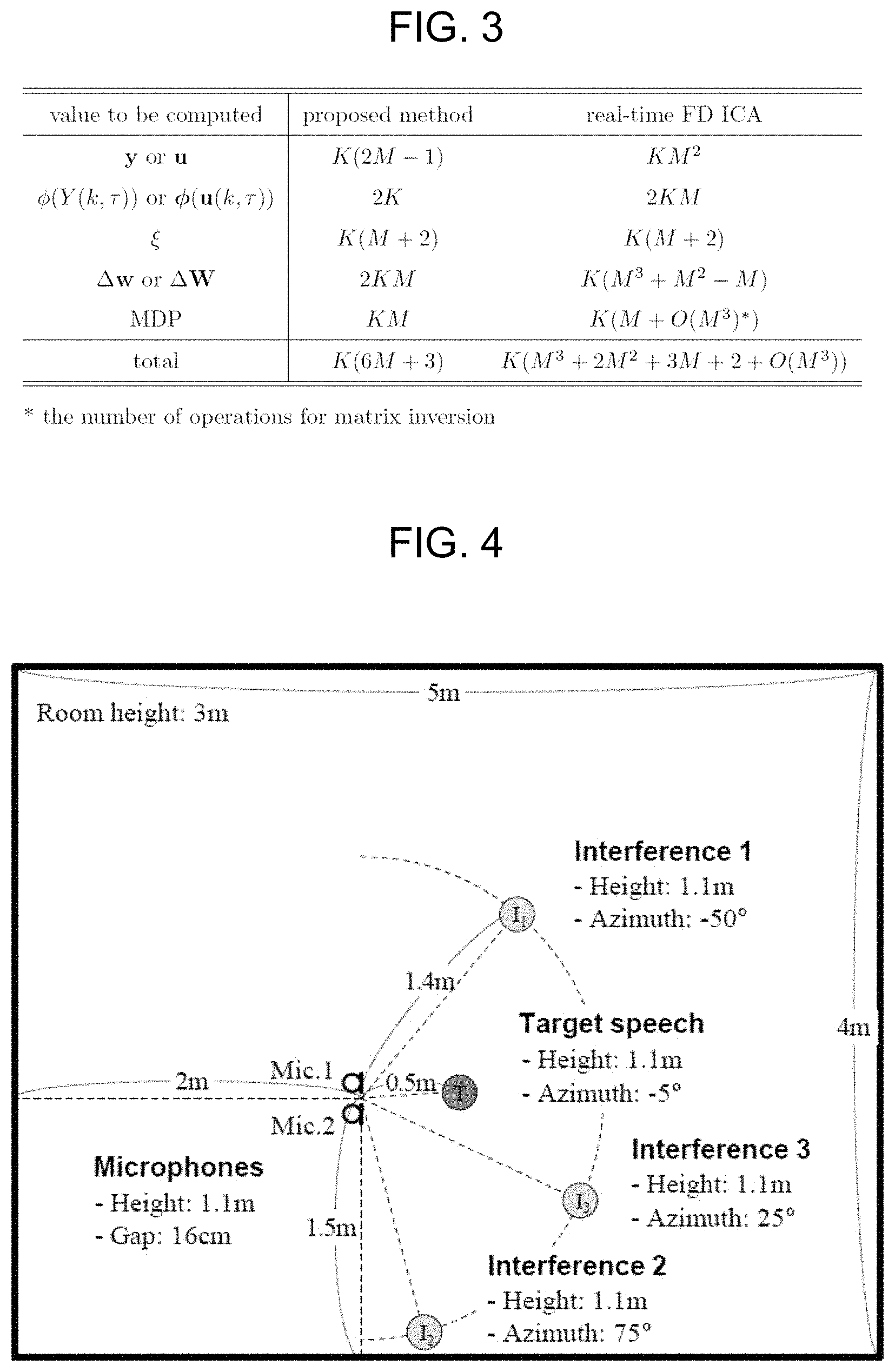

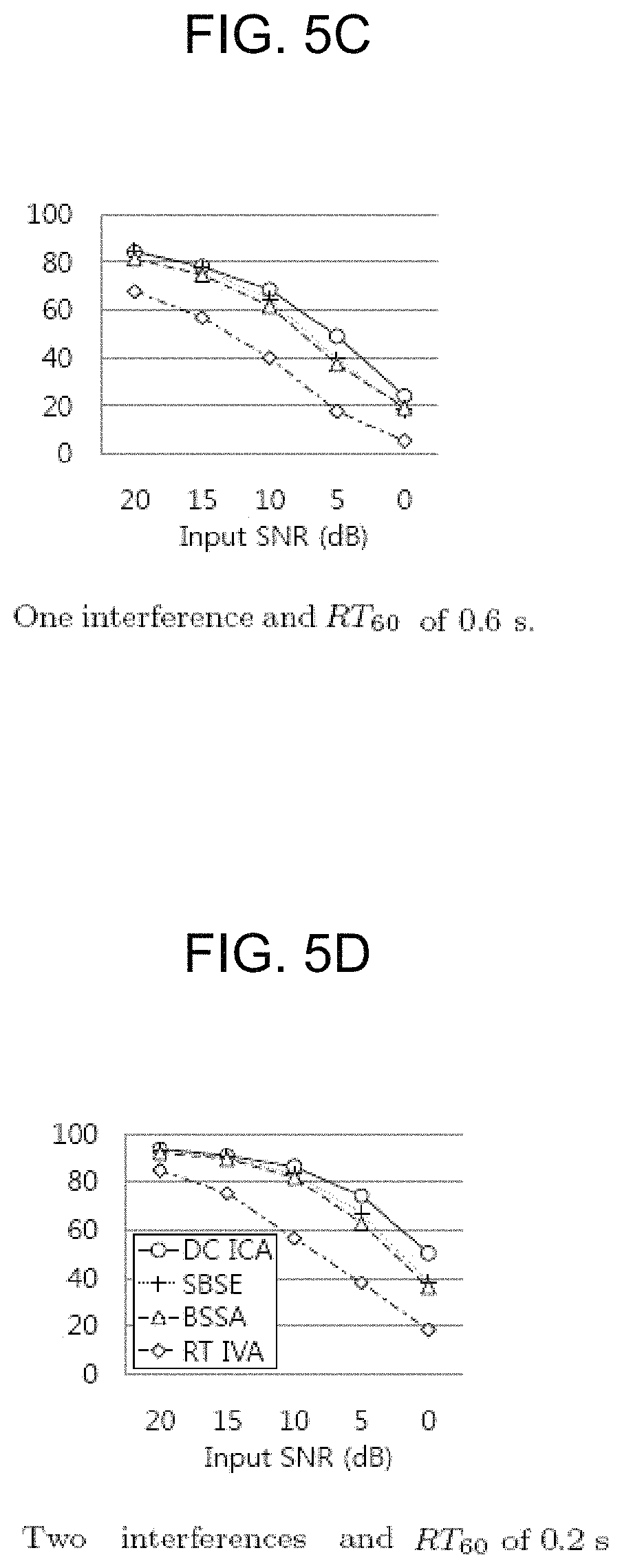


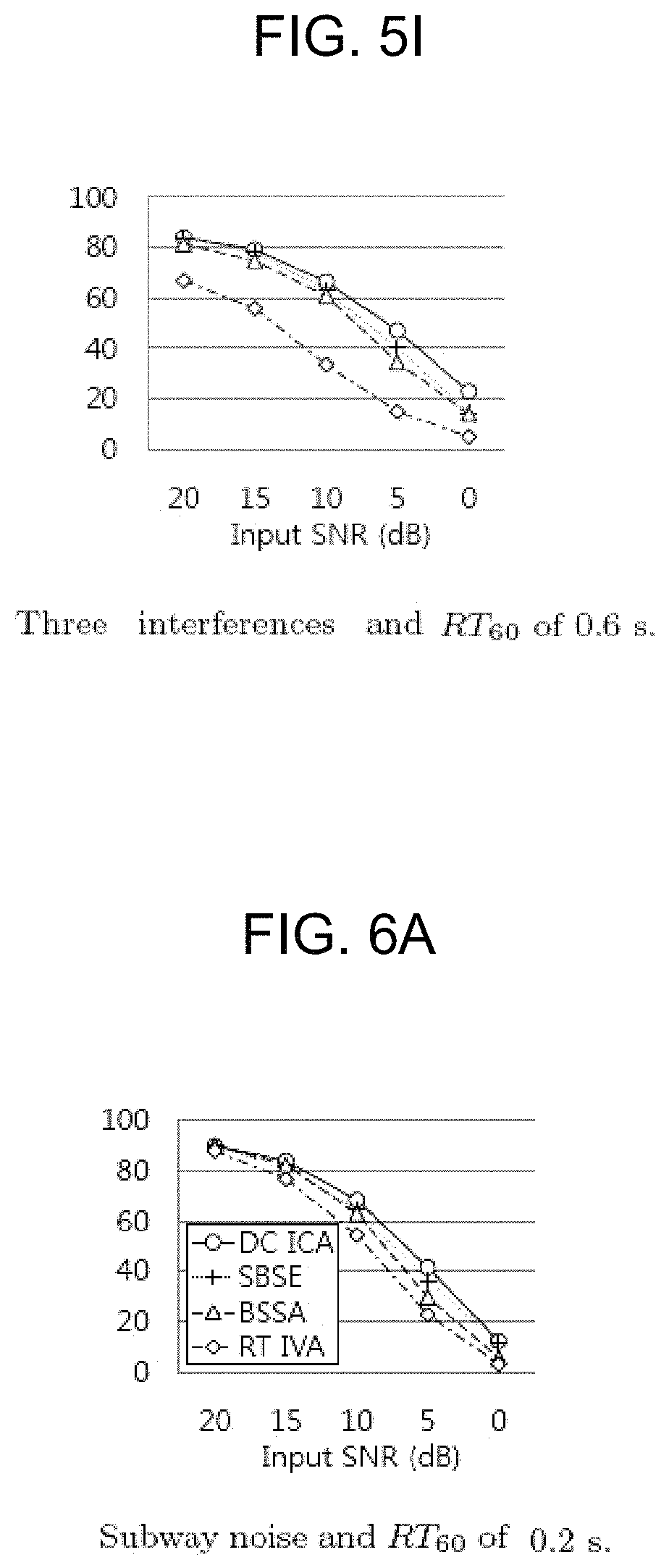
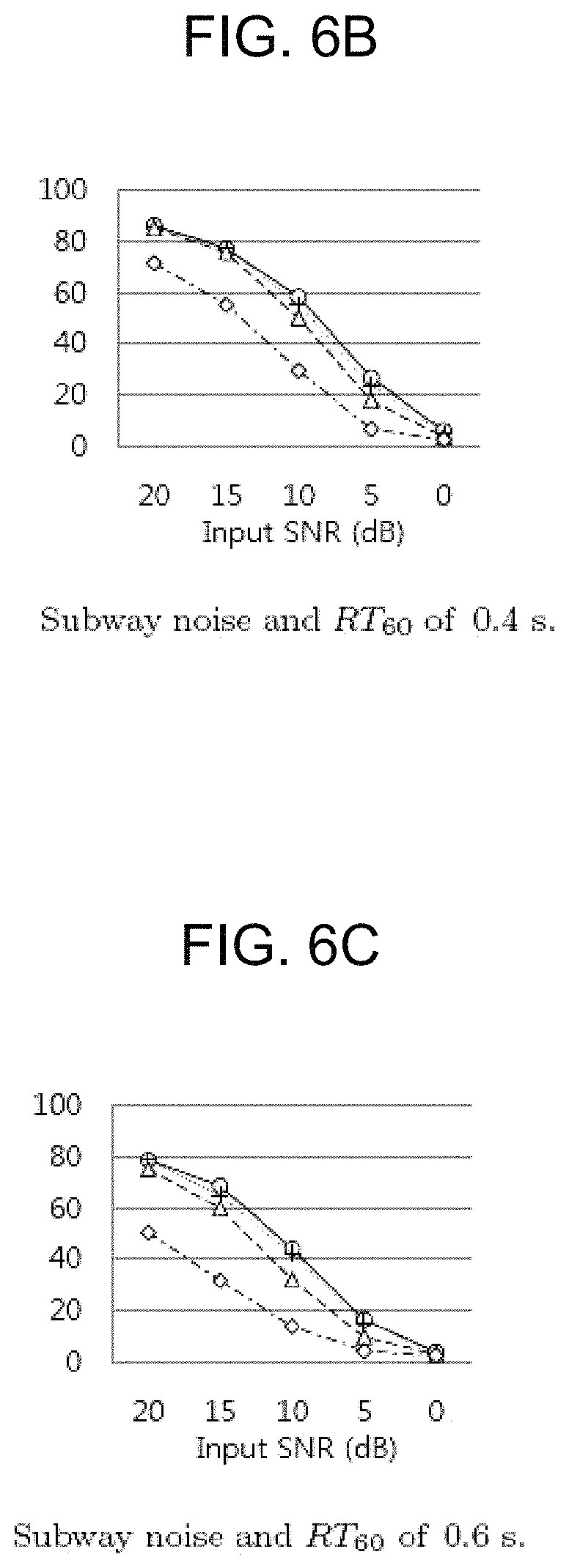


View All Diagrams
| United States Patent | 10,991,362 |
| Park , et al. | April 27, 2021 |
Online target-speech extraction method based on auxiliary function for robust automatic speech recognition
Abstract
Provided is a target speech signal extraction method for robust speech recognition including: receiving information on a direction of arrival of the target speech source with respect to the microphones; generating a nullformer by using the information on the direction of arrival of the target speech source to remove the target speech signal from the input signals and to estimate noise; setting a real output of the target speech source using an adaptive vector as a first channel and setting a dummy output by the nullformer as a remaining channel; setting a cost function for minimizing dependency between the real output of the target speech source and the dummy output using the nullformer by performing independent component analysis (ICA) or independent vector analysis (IVA); setting an auxiliary function to the cost function; and estimating the target speech signal by using the cost function and the auxiliary function.
| Inventors: | Park; Hyung Min (Seoul, KR), Lee; Seoyoung (Seoul, KR), Kim; Seung-Yun (Seoul, KR), Cho; Byung Joon (Seoul, KR), Shin; Uihyeop (Changwon-si, KR) | ||||||||||
|---|---|---|---|---|---|---|---|---|---|---|---|
| Applicant: |
|
||||||||||
| Assignee: | INDUSTRY-UNIVERSITY COOPERATION
FOUNDATION SOGANG UNIVERSITY (Seoul, KR) |
||||||||||
| Family ID: | 1000005516564 | ||||||||||
| Appl. No.: | 16/849,321 | ||||||||||
| Filed: | April 15, 2020 |
Prior Publication Data
| Document Identifier | Publication Date | |
|---|---|---|
| US 20200243072 A1 | Jul 30, 2020 | |
Related U.S. Patent Documents
| Application Number | Filing Date | Patent Number | Issue Date | ||
|---|---|---|---|---|---|
| 16181798 | Nov 6, 2018 | 10657958 | |||
| 15071594 | Mar 16, 2016 | ||||
Foreign Application Priority Data
| Mar 18, 2015 [KR] | 10-2015-0037314 | |||
| Current U.S. Class: | 1/1 |
| Current CPC Class: | H04R 1/326 (20130101); G10L 15/08 (20130101); H04R 2430/20 (20130101) |
| Current International Class: | G10L 15/08 (20060101); H04R 1/32 (20060101) |
| Field of Search: | ;704/227 |
References Cited [Referenced By]
U.S. Patent Documents
| 2005/0060142 | March 2005 | Visser |
| 2005/0203981 | September 2005 | Sawada |
| 2006/0015331 | January 2006 | Hui |
| 2006/0058983 | March 2006 | Araki |
| 2009/0055170 | February 2009 | Nagahama |
| 2009/0150146 | June 2009 | Cho |
| 2009/0222262 | September 2009 | Kim |
| 2011/0131044 | June 2011 | Fukuda |
| 2012/0020485 | January 2012 | Visser |
| 2014/0163991 | June 2014 | Short |
| 2008219458 | Sep 2008 | JP | |||
| 20030078218 | Oct 2003 | KR | |||
| 20060044008 | May 2006 | KR | |||
| 100647826 | Nov 2006 | KR | |||
| 20090081263 | Jul 2009 | KR | |||
Other References
|
Matsuoka, Minimal Distortion Principle for Blind Source Separation, Aug. 5-7, 2002, SICE, pp. 2138-2143. cited by applicant. |
Primary Examiner: Mehta; Bhavesh M
Assistant Examiner: Nguyen; Timothy
Attorney, Agent or Firm: Cantor Colburn LLP
Claims
What is claimed is:
1. A target speech signal extraction method of extracting a target speech signal from input signals input to at least two or more microphones for robust speech recognition, by a processor of a speech recognition apparatus, comprising: (a) receiving information on a direction of arrival of the target speech source with respect to the microphones; (b) generating a nullformer for removing the target speech signal from the input signals and estimating noise by using the information on the direction of arrival of the target speech source; (c) setting a real output of the target speech source using an adaptive vector w(k) as a first channel and setting a dummy output by the nullformer as a remaining channel; (d) setting a cost function for minimizing dependency between the real output of the target speech source and the dummy output using the nullformer by performing independent component analysis (ICA) or independent vector analysis (IVA); (e) setting an auxiliary function to the cost function; and (f) estimating the target speech signal by using the cost function and the auxiliary function, thereby extracting the target speech signal from the input signals, wherein the auxiliary function is set an inequality relation so that the auxiliary function has always values greater than or same as that of the cost function.
2. The target speech signal extraction method according to claim 1, wherein the direction of arrival of the target speech source is a separation angle .theta..sub.target formed between a vertical line in the microphone and the target speech source.
3. The target speech signal extraction method according to claim 1, wherein the nullformer is a "delay-subtract nullformer", and wherein the (b) includes of obtaining a relative ratio of target speech signals by using the information on the direction of arrival (DOA) of the target speech source, multiplying the relative ratio and an input signal of a microphone and subtracting the multiplied value from input signals of a pair of microphones to cancel out the target speech source component from the input signal of a microphone.
4. The target speech signal extraction method according to claim 1, wherein a probability density function of the cost function is modeling by a generalized Gaussian distribution.
5. The target speech signal extraction method according to claim 4, wherein the generalized gaussian distribution has a varying variance with regard to time-frequency or one of time and frequency, and wherein the (e) includes of updating the varying variance .lamda. and the adaptive vector w(k) alternately, and estimating the target speech signal by using the updated varying variance and the adaptive vector.
6. The target speech signal extraction method according to claim 4, wherein the generalized gaussian distribution has a constant variance, and wherein the (e) includes of learning the cost function to update the adaptive vector w(k), and estimating the target speech signal by using the updated adaptive vector.
7. The target speech signal extraction method according to claim 4, the target speech signal extraction method further comprises (f) applying a minimal distortion principle (MDP) using a target speech element of a diagonal elements in an inverse matrix of a separating matrix, to the estimated the target speech signal in the (e).
8. The target speech signal extraction method according to claim 1, wherein a time domain waveform y(k) of an estimated target speech signal is expressed by the following Mathematical Formula, and .function..tau..times..times..times..function..tau..times..times..times..- omega..function..tau..times..times. ##EQU00032## wherein Y(k, .tau.)=w(k).times.(k, .tau.), w(k) denotes an adaptive vector for generating a real output with respect to the target speech source, and k and .tau. denote a frequency bin number and a frame number, respectively.
9. A non-transitory computer readable storage media having program instructions that, when executed by a processor of a speech recognition apparatus, cause the processor to perform the target speech signal extraction method according to claim 1.
Description
BACKGROUND OF THE INVENTION
1. Field of the Invention
The present invention relates to a pre-processing method for target speech extraction in a speech recognition system or a speech recognition apparatus, and more particularly, a target speech extraction method capable of reducing a calculation amount and improving performance of speech recognition by performing independent component analysis by using information on a direction of arrival of a target speech source.
2. Description of the Prior Art
With respect to an automatic speech recognition (ASR) system, since much noise exists in real environments, noise robustness is very important to maintain. In many cases, degradation in performance of recognition of the speech recognition system are mainly caused from a difference between a learning environment and the real environment.
In general, in the speech recognition system, in a pre-processing step, a clear target speech signal which is a speech signal of a target speaker is extracted from input signals supplied through input means such as a plurality of microphones, and the speech recognition is performed by using the extracted target speech signal. In speech recognition systems, various types of pre-processing methods of extracting the target speech signal from the input signals are proposed.
In a speech recognition system using independent component analysis (ICA) of the related art, outputs signals as many as the input signals of which the number corresponds to the number of microphones are extracted, and one target speech signal is selected from the output signals. In this case, in order to select the one target speech signal from the output signals of which the number corresponds to the number of input signals, a process of identifying which direction each of the output signals are input from is required, and thus, there are problems in that a calculation amount is overloaded and the entire performance is degraded due to error in estimation of the input direction.
In a blind spatial subtraction array (BSSA) method of the related art, after a target speech signal output is removed, a noise power spectrum estimated by ICA using a projection-back method is subtracted. In this BSSA method, since the target speech signal output of the ICA still includes noise and the estimation of the noise power spectrum cannot be perfect, there is a problem in that the performance of the speech recognition is degraded.
On the other hand, in a semi-blind source estimation (SBSE) method of the related art, some preliminary information such as direction information is used for a source signal or a mixing environment. In this method, known information is applied to generation of a separating matrix for estimation of the target signal, so that it is possible to more accurately separate the target speech signal. However, since this SBSE method requires additional transformation of input mixing vectors, there are problems in that the calculation amount is increased in comparison with other methods of the related art and the output cannot be correctly extracted in the case where preliminary information includes errors. On the other hand, in a real-time independent vector analysis (IVA) method of the related art, permutation problem across frequency bins in the ICA is overcome by using a statistic model considering correlation between frequencies. However, since one target speech signal needs to be selected from the output signals, problems exist in the ICA or the like.
SUMMARY OF THE INVENTION
The present invention is to provide a method of accurately extracting a target speech signal with a reduced calculation amount.
According to an aspect of the present invention, there is provided a target speech signal extraction method of extracting the target speech signal from the input signals input to at least two or more microphones, the target speech signal extraction method including: (a) receiving information on a direction of arrival of the target speech source with respect to the microphones; (b) generating a nullformer for removing the target speech signal from the input signals and estimating noise by using the information on the direction of arrival of the target speech source; (c) setting a real output of the target speech source using an adaptive vector w(k) as a first channel and setting a dummy output by the nullformer as a remaining channel; (d) setting a cost function for minimizing dependency between the real output of the target speech source and the dummy output using the nullformer by performing independent component analysis (ICA); and (e) estimating the target speech signal by using the cost function, thereby extracting the target speech signal from the input signals.
In the target speech signal extraction method according to the above aspect, preferably, the direction of arrival of the target speech source is a separation angle .theta..sub.target formed between a vertical line in a front direction of a microphone array and the target speech source.
In the target speech signal extraction method according to the above aspect, preferably, the nullformer is a "delay-subtract nullformer" and cancels out the target speech signal from the input signals input from the microphones.
In the target speech extraction method according to the present invention, in a speech recognition system, a target speech signal can be allowed to be extracted from input signals by using information of a target speech direction of arrival which can be supplied as preliminary information, and thus, the total calculation amount can be reduced in comparison with the extraction methods of the related art, so that a process time can be reduced.
In the target speech extraction method according to the present invention, a nullformer capable of removing a target speech signal from input signals and extracting only a noise signal is generated by using information of a direction of arrival of the target speech, and the nullformer is used for independent component analysis (ICA), so that the target speech signal can be more stably obtained in comparison with the extraction methods of the related art.
The present invention is to provide a non-transitory computer readable storage media having program instructions that, when executed by a processor of a speech recognition apparatus or a speech recognition system, cause the processor to perform the target speech signal extraction method according to the above-mentioned aspect of the present invention.
BRIEF DESCRIPTION OF THE DRAWINGS
FIG. 1 is a configurational diagram illustrating a plurality of microphones and a target source in order to explain a target speech extraction method for robust speech recognition according to the present invention.
FIG. 2 is a flowchart sequentially illustrating an algorithm according to a target speech extraction method for robust speech recognition according to the present invention.
FIG. 3 is a table illustrating comparison of calculation amounts required for processing one data frame between a method according to the present invention and a real-time FD ICA method of the related art.
FIG. 4 is a configurational diagram illustrating a simulation environment configured in order to compare performance between the method according to the present invention and methods of the related art.
FIGS. 5A to 5I are graphs illustrating results of simulation of the method according to the present invention (referred to as `DC ICA`), a first method of the related art (referred to as `SBSE`), a second method of the related art (referred to as `BSSA`, and a third method of the related art (referred to as `RT IVA`) while adjusting the number of interference speech sources under the simulation environment of FIG. 4.
FIGS. 6A to 6I are graphs of results of simulation the method according to the present invention (referred to as `DC ICA`), the first method of the related art (referred to as `SBSE`), a second method of the related art (referred to as `BSSA`), and a third method of the related art (referred to as `RT IVA`) by using various types of noise samples under the simulation environment of FIG. 4.
FIGS. 7A and 7B illustrate a subband clique and a harmonic clique as two typical clique cases.
DETAILED DESCRIPTION OF THE INVENTION
The present invention relates to a target speech signal extraction method for robust speech recognition and a speech recognition pre-processing system employing the aforementioned target speech signal extraction method, and independent component analysis is performed in the assumption that a target speaker direction is known, so that a total calculation amount of speech recognition can be reduced and fast convergence can be performed.
Hereinafter, a pre-processing method for robust speech recognition according to an exemplary embodiment of the present invention will be described in detail with reference to the attached drawings.
The present invention relates to a pre-processing method of a speech recognition system for extracting a target speech signal of a target speech source that is a target speaker from input signals input to at least two or more microphones. The method includes receiving information on a direction of arrival of the target speech source with respect to the microphones; generating a nullformer by using the information on the direction of arrival of the target speech source to remove the target speech signal from the input signals and to estimate noise; setting a real output of the target speech source using an adaptive vector w(k) as a first channel and setting a dummy output by the nullformer as a remaining channel; setting a cost function for minimizing dependency between the real output of the target speech source and the dummy output using the nullformer by performing independent component analysis (ICA); and estimating the target speech signal by using the cost function, thereby extracting the target speech signal from the input signals.
In a target speech signal extraction method according to the exemplary embodiment of the present invention, a target speaker direction is received as preliminary information, and a target speech signal that is a speech signal of a target speaker is extracted from signals input to a plurality of (M) microphones by using the preliminary information.
FIG. 1 is a configurational diagram illustrating a plurality of microphones and a target source in order to explain a target speech extraction method for robust speech recognition according to the present invention. Referring to FIG. 1, set are a plurality of the microphones Mic.1, Mic.2, . . . , Mic.m, and Mic.M and a target speech source that is a target speaker. A target speaker direction that is a direction of arrival of the target speech source is set as a separation angle .theta..sub.target between a vertical line in the front direction of a microphone array and the target speech source.
In FIG. 1, an input signal of an m-th microphone can be expressed by Mathematical Formula 1.
.function..tau..function..times..times..times..function..tau..times..time- s..times..function..tau..times..times..times..times. ##EQU00001##
Herein, k denotes a frequency bin number and .tau. denotes a frame number. S.sub.1(k, .tau.) denotes a time-frequency segment of a target speech signal constituting the first channel, and S.sub.n(k, .tau.) denotes a time-frequency segment of remaining signals excluding the target speech signal, that is, noise estimation signals. A(k) denotes a mixing matrix in a k-th frequency bin.
In a speech recognition system, the target speech source is usually located near the microphones, and acoustic paths between the speaker and the microphones have moderate reverberation components, which means that direct-path components are dominant. If the acoustic paths are approximated by the direct paths and relative signal attenuation among the microphones is negligible assuming proximity of the microphones without any obstacle, a ratio of target speech source components in a pair of microphone signals can be obtained by using Mathematical Formula 2.
.function..times..times..times..function..tau..function.'.times..times..f- unction..tau..apprxeq..times..times..times..omega..times..function.'.times- ..times..times..times..theta..times..times..times..times. ##EQU00002##
Herein, .theta..sub.target denotes the direction of arrival (DOA) of the target speech source. Therefore, a "delay-and-subtract nullformer" that is a nullformer for canceling out the target speech signal from the first and m-th microphones can be expressed by Mathematical Formula 3.
.function..tau..function..tau..times..times..times..omega..times..functio- n..times..times..times..theta..times..function..tau..times..times..times..- times..times. ##EQU00003##
The nullformer obtains the relative ratio of target speech signals by using the information on the direction of arrival of the target speech source, multiplies the relative ratio and an input signal of a microphone and subtracts the multiplied value from input signals of a pair of microphones so that the nullformer is configured for canceling out the target speech source component from the input signal of a microphone.
In order to derive a learning rule, the nullformer outputs are regarded as dummy outputs, and the real target speech output is expressed by Mathematical Formula 4. Y.sub.1(k,.tau.)=w.sub.1.sup.H(k).times.(k,.tau.) [Mathematical Formula 4]
Herein, H denotes the Hermitian transpose and w.sub.1(k) denotes the adaptive vector for generating the real output. Therefore, the real output and the dummy output can be expressed in a matrix form by Mathematical Formula 5.
.function..tau..function..gamma..times..function..tau..times..times..time- s..times. ##EQU00004##
Herein, y(k, .tau.)=[Y.sub.1(k, .tau.), Y.sub.2(k, .tau.), . . . , Y.sub.M(k, .tau.)].sup.T, .gamma..sub.k=|.GAMMA..sub.k.sup.1, . . . ,.GAMMA..sub.k.sup.M-1|.sup.T, and .GAMMA..sub.k=exp{j.omega..sub.kd sin .theta..sub.target/c}.
For consistency,
.function..function..times..function..function..gamma. ##EQU00005##
Nullformer parameters for generating the dummy output are fixed to provide noise estimation. As a result, according to the present invention, permutation problem over the frequency bins can be solved. Unlike an IVA method, the estimation of w.sub.1(k) at a frequency bin independent of other frequency bins can provide fast convergence, so that it is possible to improve performance of target speech signal extraction as pre-processing for the speech recognition system.
Therefore, according to the present invention, by maximizing independency between the real output and the dummy output at one frequency bin, it is possible to obtain a desired target speech signal from the real output.
With respect to the cost function, by Kullback-Leibler (KL) divergence between probability density functions p(Y.sub.1(k, .tau.), Y.sub.2(k, .tau.), . . . , Y.sub.M(k, .tau.)) and q(Y.sub.1(k, .tau.))p(Y.sub.2(k, .tau.), . . . , Y.sub.M(k, .tau.)), the terms independent of w.sub.1(k) are removed, so that the cost function can be expressed by Mathematical Formula 6 of which is the target speech extraction method based on the independent component analysis (DC ICA).
'.function..times..times..times..times..times..GAMMA..function..function.- .times. .times..times..function..function..tau..times..times..times..times- . ##EQU00006##
Herein, [-].sub.m denotes an m-th element of a vector.
In addition, it may be worth considering the method for target speech extraction based on Independent Vector Analysis(DC IVA) in which the cost function using y.sub.m(.tau.)=[Y.sub.m (1, .tau.), Y.sub.m(2, .tau.), . . . , Y.sub.m(K, .tau.)].sup..GAMMA. in consideration of the dependency between frequency components sets as follows.
'.function..times..times..times..GAMMA..function..function..function..tim- es..times..function..function..tau..times..times..times..times. ##EQU00007##
Because the above-mentioned DC ICA and DC IVA methods converge by using maximum gradient algorithm, there is a trade-off between the convergence velocity due to the step size of learning rate and the stability.
On the other hand, the target speech extraction method using auxiliary function sets the auxiliary function Q and is able to minimize fast without need for setting suitably the step size of learning rate. The auxiliary function Q may be set the inequality relation using an inequality
.function..ltoreq.'.function..times..times..function..times.'.function. ##EQU00008## so that the auxiliary function has always values greater than or same as that of the objective function.
Accordingly, through the optimization of the auxiliary function, the objective function which has always a value smaller than or same as that of the auxiliary function may be optimized along with it.
In the DC ICA method, the relationship between the auxiliary function and the objective function is as follows.
'.ltoreq..times..times..function..times..times.'.function..function..tau.- .times..function..tau..times..function..tau..times..times..times..times..G- AMMA..function..function..times..times..function..times..function..times..- function..times..times..times..times..GAMMA..function..function..times..ti- mes..times..times. ##EQU00009##
Here, R is a constant irrelevant to the estimated vector w.sub.1(k). In the DC ICA method, V.sub.m(k) is as follows.
.function..function.'.function..function..tau..function..tau..times..func- tion..tau..times..function..tau..times..times..times..times. ##EQU00010##
Here, r.sub.m(k, .tau.)=|Y.sub.m(k, .tau.)|=|w.sub.m.sup.H(k).times.(k, .tau.)|, and G'(r.sub.m(k, .tau.)) denotes a differentiation of G(r.sub.m(k, .tau.))=-log q(Y.sub.m(k, .tau.)) by r.sub.m(k, .tau.).
Meanwhile, it can be expressed a probability density function of various speech sources in the time-frequency domain by modeling q(Y.sub.m(k, .tau.)) as a probability density function following the Generalized Gaussian distribution expressed by Mathematical Formula 10.
.function..function..tau..varies..lamda..function..tau..times..times..fun- ction..tau..lamda..function..tau..beta..times..times..times..times. ##EQU00011##
Herein, .lamda..sub.m(k, .tau.) and .beta. are variance and shape parameter, respectively, and the type of pdf can be determined according to the value of these parameters. For example, if the pdf is a Laplace distribution with a unit variance, .beta.=1/2 and .lamda..sub.m(k, .tau.)=1, and if the pdf is a Gaussian distribution, then .beta.=1.
In addition, in the DC IVA method, the extended probability density function using clique may be used as follows.
.function..function..tau..varies..PI..times..lamda..function..tau..times.- .times..times..times..SIGMA..di-elect cons..OMEGA..times..function..tau..lamda..function..tau..beta..times..tim- es..times..times. ##EQU00012##
Herein, c, N.sub.c and .OMEGA..sub.c are a clique index, a quantity of the clique and a set of frequency bin included in the corresponding clique, respectively. Also, .lamda..sub.m(c, .tau.) and .beta. are a variance and a shape parameter of the c-th clique in the m-th output, respectively. Herein, it can be expressed the probability density function of various kinds according to a design of the clique structure and a setting of the shape parameter and the variance.
Also, in the DC IVA method based on the clique, the relationship between the objective function and the auxiliary function is as follows.
'.ltoreq..times..times..function..times..times..SIGMA..di-elect cons..OMEGA..times..function..tau..lamda..beta..function..tau..beta..time- s..times..times..times..GAMMA..function..function..times..times..function.- .times..function..times..function..times..times..times..times..GAMMA..func- tion..function..times..times..times..times. ##EQU00013##
Therefore, v.sub.m(k) is given as follows.
.function..function..times..times..SIGMA..di-elect cons..OMEGA..times..function..tau..beta..lamda..beta..function..tau..time- s..function..tau..times..function..tau..times..times..times..times. ##EQU00014##
To optimize the auxiliary function Q to w.sub.1(k), w.sub.1(k) satisfying the mathematical formula 14 is obtained.
.differential..differential..function..times..times..function..times..fun- ction..differential..differential..function..times..times..times..times..G- AMMA..function..function..times..times..times..times. ##EQU00015##
Therefore, w.sub.1(k) is satisfied the mathematical formula 15. W(k)V.sub.1(k)w.sub.1(k)=e.sub.1 [Mathematical Formula 15]
Herein, e.sub.m is a vector of which the m-th component only is 1 and the other components are all 0. Therefore, w.sub.1(k) satisfies the following mathematical formula 16. w.sub.1(k)=(W(k)V.sub.1(k)).sup.-1e.sub.1 [Mathematical Formula 16]
w.sub.1(k) may be normalized according to the mathematical formulas 17 or 18 as follows.
.function..function..function..times..function..times..function..times..t- imes..times..times..function..function..function..times..function..times..- times..times..times. ##EQU00016##
In addition, suppose that .lamda..sub.m(k, .tau.) is a variance of varying according to time or frequency, the method for estimating the .lamda..sub.m(k, .tau.) can be proposed variously.
For example,
.lamda..function..tau..beta..beta..times..function..tau. ##EQU00017## can be estimated through the likelihood maximization algorithm, or
.lamda..function..tau..beta..function..function..tau..lamda..function..ta- u..beta..times..function..tau. ##EQU00018## can be estimated through the recursive estimation method, where .lamda..sub.m(k, .tau.) in the right side of the equation can be modified to .lamda..sub.m(k, .tau.-1).
.lamda..sub.m(k, .tau.)=1/4|Y.sub.m(k, .tau.)| in the Laplace distribution with .beta.=1/2, and .lamda..sub.m(k, .tau.)=|Y.sub.m(k, .tau.)|.sup.2 in the Gaussian distribution with .beta.=1.
Also, .lamda..sub.m(k, .tau.) can be estimated as the equation of
.lamda..function..tau..beta..beta..times..times..tau.'.tau..tau..times..t- imes..function..tau.' ##EQU00019## by considering the value of the adjacent time frame and including N.sub..alpha. frames existing on the front and the rear of the current time frame .tau., respectively, or .lamda..sub.m(k, .tau.) can be estimated as the equation of
.lamda..function..tau..beta..times..times..tau.'.tau..tau..times..functio- n..times..function..tau.'.lamda..function..tau.'.beta..times..function..ti- mes..function..tau.' ##EQU00020## through the recursive estimation method, where .lamda..sub.m(k, .tau.) in the right side of the equation can be modified to .lamda..sub.m(k, .tau.-1).
Similarly, .lamda..sub.m(k, .tau.) can be estimated by the recursive equation of .lamda..sub.m(k, .tau.)=.gamma.|Y.sub.m(k, .tau.)|.sup.2+(1-.gamma.).lamda..sub.m(k, .tau.-1), where .gamma. denoted a smoothing parameter. Therefore, .lamda..sub.1(k, .tau.) and w.sub.1(k) updates repeatedly in turn to be converged.
In addition, due to Y.sub.1(k, .tau.).times.w.sub.1.sup.H(k).times.(k, .tau.), .lamda..sub.1(k, .tau.) can be initialized by various methods including above mentioned methods through the initial value of w.sub.1(k). If the initial value of w.sub.1(k) is set a unit vector of which the m-th element is 1, the initial value of .lamda..sub.1(k, .tau.) can be measured by a power of input signal of an individual microphone. In another method, .lamda..sub.1(k, .tau.) can be measured approximately by an improved signal power through the beamformer using DOA.
Also, In a method based of the clique, suppose that .lamda..sub.m(c, .tau.) is a variance varying according to time or clique, the method for estimating .lamda..sub.m(c, .tau.) can be proposed variously in the same way.
For example,
.lamda..function..tau..beta..beta..times..SIGMA..di-elect cons..OMEGA..times..function..tau. ##EQU00021## can be estimated through the maximum likelihood method, or
.lamda..function..tau..times..SIGMA..di-elect cons..OMEGA..times..function..tau..lamda..function..tau..beta..times..SIG- MA..di-elect cons..OMEGA..times..function..tau. ##EQU00022## can be estimated through the recursive estimation method, where .lamda..sub.m(c, .tau.) in the right side of the equation can be modified to .lamda..sub.m(c, .tau.-1).
In Addition, in the target speech extraction method (DC ICA and DC IVA) using auxiliary function, if the auxiliary function is set with the distortionless constraint which the input and output signals coming from the direction of the target speech using prior information are identical with each other, the scaling indeterminacy of signal which is estimated by a parameter updated in conventional method does not generate fundamentally.
Therefore, it can be obtained the signal having a distortion smaller than the conventional method, without applying the minimum distortion principle MDP to resolve the scaling indeterminacy problem in the conventional method.
If the distortionless constraint w.sub.1.sup.H(k)h(k)=1, and nullforming constraint w.sub.m.sup.H(k)h(k)=0, (m.noteq.1) are added to the auxiliary function Q, the auxiliary function Q is given as follows.
'.times..times..times..function..times..function..times..function..alpha.- .function..function..times..function..beta..times..times..function..times.- .times..times..times. ##EQU00023##
Here, h(k) is a direction vector [.GAMMA..sub.k.sup.0, .GAMMA..sub.k.sup.1, . . . , .GAMMA..sub.k.sup.M-1].sup.T to a target speech, and .beta..sub.m is 1 in m=1, and 0 in m.noteq.1. To minimize the above extended auxiliary function Q', the estimation equation of w.sub.1.sup.H(k) is given as follows.
.function..function..times..function..times..function..times..function..t- imes..function..times..times..times..times..times. ##EQU00024##
Until now, the method which only w.sub.1.sup.H(k) is estimated repeatedly by using the above equation and the remaining w.sub.m.sup.H(k) is fixed to nullformer was proposed. However, for performance improvement, the remaining w.sub.m.sup.H(k), m.noteq.1 may be estimated repeatedly together by using the mathematical formula 21.
.times..function..function..times..function..times..times..times..functio- n..function..function..times..function..times..function..times..times..tim- es..times..function..function..function..times..function..times..times..ti- mes..times. ##EQU00025##
To induce the real time target speech extraction method based on the auxiliary function, if the inverse matrix of V.sub.m(k) in time frame .tau. is denoted U.sub.m(k; .tau.) and the inverse matrix of W(k) is denoted A(k; .tau.), U.sub.m(k; .tau.) can be obtained recursively from U.sub.m(k; .tau.-1), as follows.
.function..tau..alpha..times..function..tau..function..tau..times..functi- on..tau..times..tau..times..function..tau..times..function..tau..alpha..fu- nction..tau..times..function..tau..function..tau..times..function..tau..ti- mes..times..function..tau..function..tau..function..tau..times..times..DEL- TA..times..times..function..tau..times..function..tau..DELTA..times..times- ..function..tau..times..function..tau..times..times..times..times..times. ##EQU00026##
Here, suppose that w.sub.m(k) is w.sub.m(k; .tau.) in the time frame .tau.. In addition,
.function..tau..alpha..times.'.function..function..tau..function..tau. ##EQU00027## and .DELTA.w.sub.m(k; .tau.)=w.sub.m(k; .tau.)-w.sub.m(k; .tau.-1) using forgetting factor .alpha.. Therefore, w.sub.1(k; .tau.) can be estimated as follows. w.sub.1(k;.tau.)=U.sub.1(k;.tau.)A(k;.tau.)e.sub.1 [Mathematical Formula 23]
As occasion demands, the norming is performed.
In order to resolve scaling indeterminacy of the output signal by applying a minimal distortion principle (MDP) to the obtained output Y.sub.1(k, .tau.)=w.sub.1.sup.H(k; .tau.).times.(k, .tau.) obtained by using the w.sub.1(k; .tau.), the diagonal elements of an inverse matrix of a separating matrix needs to be obtained.
Due to the structural features, the inverse matrix
.function..tau..gamma. ##EQU00028## of the above-described matrix can be simply obtained by calculating only a factor 1/.SIGMA..sub.m=1.sup.M.GAMMA..sub.k.sup.m-1[w.sub.1.sup.H(k; .tau.)].sub.m for the target output and multiplying the factor to the output.
The real time target speech extraction method which the distortionless constraint and nullforming constraint are added to the auxiliary function is exchanged to the mathematical formula 24 from the mathematical formula 10.
.function..tau..function..tau..times..function..tau..times..function..tim- es..function..tau..times..function..tau..times..times..times..times..times- . ##EQU00029##
If w.sub.m.sup.H(k; .tau.),m.noteq.1 is estimated repeatedly, the following mathematical formula.
.times..function..tau..function..tau..times..function..tau..times..times.- .times..function..tau..function..tau..function..tau..times..function..tau.- .times..function..tau..times..times..times..times..function..tau..function- ..tau..function..tau..times..function..tau..times..times..times..times. ##EQU00030##
Next, a time domain waveform of the estimated target speech signal can be reconstructed by Mathematical Formula 26.
.function..tau..times..times..times..function..tau..times..times..times..- omega..function..tau..times..times..times..times..times..times. ##EQU00031##
FIG. 2 is a flowchart illustrating sequentially the procedure of algorithm of the target speech extraction method according to the present invention.
FIG. 3 is a table illustrating comparison of calculation amounts required for calculating values of the first column of one data frame between a method according to the present invention and a real-time FD ICA method of the related art.
In FIG. 3, M denotes the number of input signals as the number of microphones. K denotes frequency resolution as the number of frequency bins. O(M) and O(M.sup.3) denotes a calculation amount with respect to a matrix inverse transformation. It can be understood from FIG. 3 that the method of the related art requires more additional computations than the method according to the present invention in order to resolve the permutation problem and to identify the target speech output.
FIG. 4 is a configurational diagram illustrating a simulation environment configured in order to compare performance between the method according to the present invention and methods of the related art. Referring to FIG. 4, there is a room having a size of 3 m.times.4 m where two microphones Mic.1 and Mic.2 and a target speech source T are provided and three interference speech sources Interference 1, Interference 2, and Interference 3 are provided. FIGS. 5A to 5I are graphs of results of simulation of the method according to the present invention (referred to as `DC ICA`), a first method of the related art (referred to as `SBSE`), a second method of the related art (referred to as `BSSA`, and a third method of the related art (referred to as `RT IVA`) while adjusting the number of interference speech sources under the simulation environment of FIG. 4. FIG. 5A illustrates a case where there is one interference speech source Interference 1 and RT.sub.60=0.2 s. FIG. 5b illustrates a case where there is one interference speech source Interference 1 and RT.sub.60=0.4 s. FIG. 5C illustrates a case where there is one interference speech source Interference 1 and RT.sub.60=0.6 s. FIG. 5D illustrates a case where there are two interference speech sources Interference 1 and Interference 2 and RT.sub.60=0.2 s. FIG. 5E illustrates a case where there are two interference speech sources (Interference 1 and Interference 2 and RT.sub.60=0.4 s. FIG. 5F illustrates a case where there are two interference speech sources (Interference 1 and Interference 2 and RT.sub.60=0.6 s. FIG. 5G illustrates a case where three are two interference speech sources Interference 1, Interference 2, and Interference 3 and RT.sub.60=0.2 s. FIG. 5H illustrates a case where three are two interference speech sources Interference 1, Interference 2, and Interference 3 and RT.sub.60=0.4 s. FIG. 5I illustrates a case where three are two interference speech sources Interference 1, Interference 2, and Interference 3 and RT.sub.60=0.6 s. In each graph, the horizontal axis denotes an input SNR (dB), and the vertical axis denotes word accuracy (%).
It can be easily understood from FIGS. 5A to 5I that the accuracy of the method according to the present invention is higher than those of the methods of the related art.
FIGS. 6A to 6I are graphs of results of simulation the method according to the present invention (referred to as `DC ICA`), the first method of the related art (referred to as ` SBSE`), a second method of the related art (referred to as `BSSA`), and a third method of the related art (referred to as `RT IVA`) by using various types of noise samples under the simulation environment of FIG. 4. FIG. 6A illustrates a case of subway noise and R T.sub.60=0.2 s. FIG. 6B illustrates a case of subway noise and R T.sub.60=0.4 s. FIG. 6C illustrates a case of subway noise and R T.sub.60=0.6 s. FIG. 6D illustrates a case of car noise and R T.sub.60=0.2 s. FIG. 6E illustrates a case of car noise and R T.sub.60=0.4 s. FIG. 6F illustrates a case of car noise and R T.sub.60=0.6 s. FIG. 6G illustrates a case of exhibition hall noise and R T.sub.60=0.2 s. FIG. 6H illustrates a case of exhibition hall noise and R T.sub.60=0.4 s. FIG. 6I illustrates a case of exhibition hall noise and R T.sub.60=0.6 s. In each graph, the horizontal axis denotes an input SNR (dB), and the vertical axis denotes word accuracy (%).
It can be easily understood from FIGS. 6A to 6I that the accuracy of the method according to the present invention is higher than those of the methods of the related art with respect to all kinds of noise.
FIGS. 7A and 7B illustrate a subband clique and a harmonic clique as two typical clique cases.
While the present invention has been particularly shown and described with reference to exemplary embodiments thereof, it will be understood by those skilled in the art that various changes in form and details may be made therein without departing from the spirit and scope of the present invention as defined by the appended claims.
A target speech signal extraction method according to the present invention can be used as a pre-processing method of a speech recognition system.
* * * * *
D00000

D00001

D00002

D00003

D00004

D00005

D00006

D00007

D00008

D00009

D00010

D00011

D00012
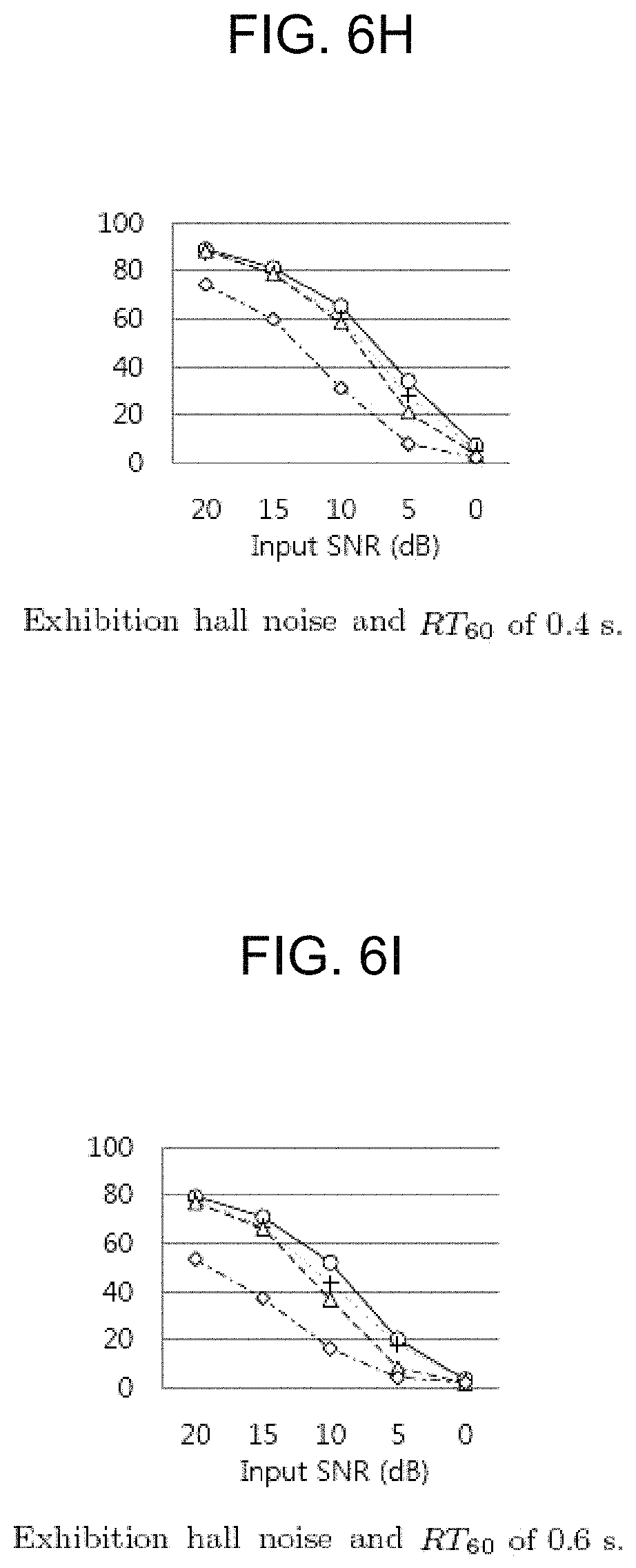
D00013
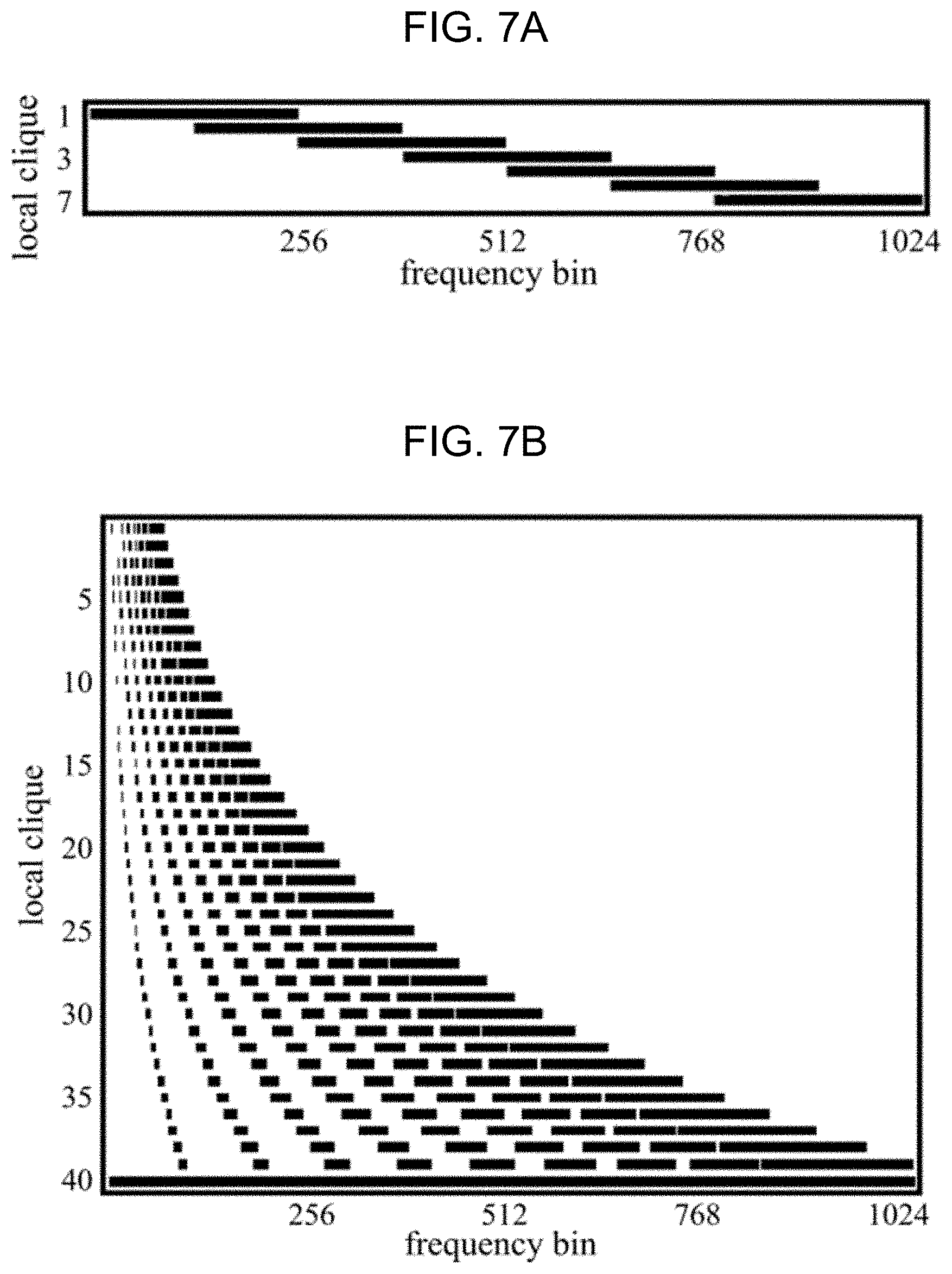
M00001

M00002

M00003

M00004

M00005

M00006

M00007

M00008

M00009
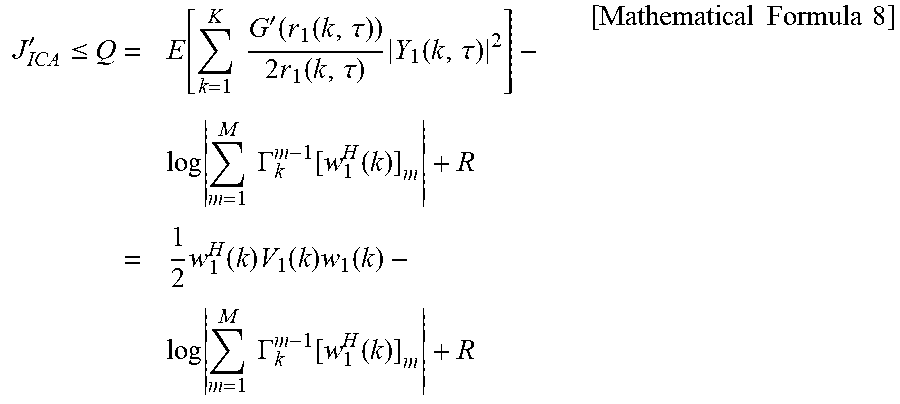
M00010

M00011

M00012

M00013

M00014

M00015

M00016

M00017

M00018

M00019

M00020

M00021

M00022

M00023

M00024

M00025

M00026

M00027

M00028

M00029

M00030

M00031

M00032

XML
uspto.report is an independent third-party trademark research tool that is not affiliated, endorsed, or sponsored by the United States Patent and Trademark Office (USPTO) or any other governmental organization. The information provided by uspto.report is based on publicly available data at the time of writing and is intended for informational purposes only.
While we strive to provide accurate and up-to-date information, we do not guarantee the accuracy, completeness, reliability, or suitability of the information displayed on this site. The use of this site is at your own risk. Any reliance you place on such information is therefore strictly at your own risk.
All official trademark data, including owner information, should be verified by visiting the official USPTO website at www.uspto.gov. This site is not intended to replace professional legal advice and should not be used as a substitute for consulting with a legal professional who is knowledgeable about trademark law.